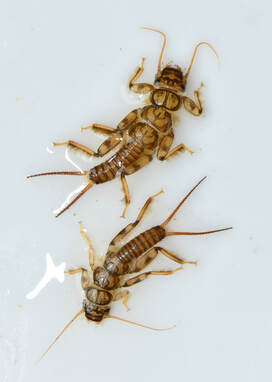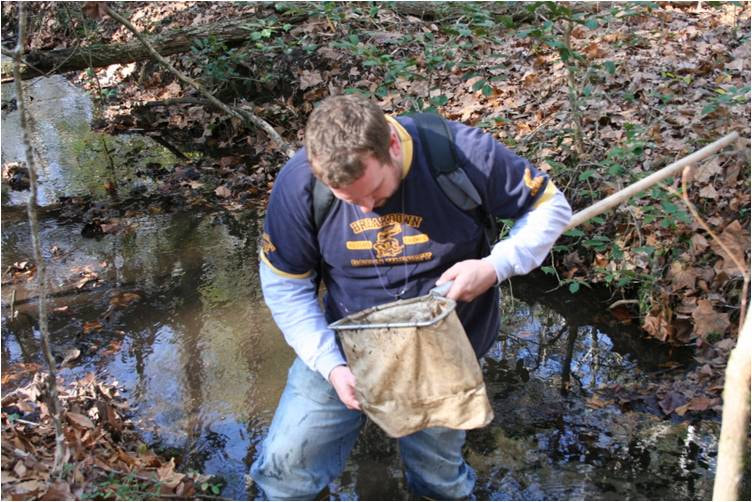Making the Case to Increase Macroinvertebrates Use in Stream Restoration Assessment/Monitoring3/16/2022 Why are insects living in streams important? How do people restoring streams determine they are successful? One entomologist wants you to know about an easier way to determine the health of a stream and if those fish you are looking for might be there. By Rich Biemiller, Ph.D. When people speak about aquatic macroinvertebrates, they are generally referring to immature insects and other small organisms that live in water and can be seen with the naked eye. Macroinvertebrates have long been used to assess water quality and, in particular, stream health. Since then, scientists have developed numeric values to describe and increase the effectiveness of using macroinvertebrates for assessment and monitoring of freshwater environments. The relative smaller size and shorter life cycles of most of these macroinvertebrates allow their communities to respond more quickly to disturbance (i.e., introduction of pollution) than larger, longer lived organisms, such as fish. This ultimately allows scientists to discover water quality issues earlier. Additionally, the effort, cost, and equipment required to sample macroinvertebrates are all significantly lower than those required to sample fish. The question then becomes: Why do many stream restoration monitoring efforts choose to focus on fish (often trout) while all but ignoring macroinvertebrates to determine success? In my opinion there are two central explanations for this: money and expertise. Money follows fish, especially game fish, and in particular trout. Many restoration projects are initiated to increase the numbers and range of native, desirable game fish. There is nothing inherently wrong with this. Using fish makes complete sense since, in many cases, because money from sales of fishing licenses or from fishing organizations provide the funding for restoration projects. As a result, monitoring the target fish after the completion of the project is logical. However, ignoring the macroinvertebrate community presents an incomplete picture of stream health and can prevent solving real fish re-establishment problems. For instance, if a stream has been restored, why have the fish not returned? Macroinvertebrate communities can provide many useful insights to help stream restoration projects solve complicated problems. Diverse, robust, pollution-sensitive macroinvertebrate communities in restored parts of the stream show that fish have a viable food source and clean water- two critical requirements that increase the chance a fish population will successfully establish. Additionally, many macroinvertebrates fly for a portion of their life cycle meaning they can re-inhabit areas that fish may not be able to access. Therefore, a healthy macroinvertebrate community persistently noted in an area where fish populations are low can indicate either a lack of suitable fish habitat (structure or deep pools) or a connectivity barrier between the source fish population and the project site. The second reason why stream restoration projects ignore macroinvertebrates is that identification of these creatures is hard and takes expertise. Even to an expert, identification of some organisms to the species level can prove extremely difficult. Further, the fact that macroinvertebrates consist of insects and other non-insect organisms mean that more than one expert may be required to identify all sampled organisms to the species level. Yes, identification of macroinvertebrates to species level is not easy. I can personally attest to this. I tried several times before getting certified in aquatic insect identification at the family level! However, identifying all organisms from a sub-sample to the species level is not always necessary to get a good idea of what is going on in the water. Simply being able to recognize that major groups of insects are missing provides valuable information. For example, a community lacking mayflies, stoneflies, or caddisflies where one would expect to find them would indicate a water quality issue that needs further investigation. Additionally, with the rise of environmental DNA techniques that allow species to be identified from water samples, the need for specialized expertise may become moot if this task can be outsourced with technology and become more affordable in the future. To be clear, I am not advocating forsaking the monitoring of fish. Rather, I would suggest that a macroinvertebrate component be added to monitoring protocols. This community is vital for the success of fish populations and assessing stream health restoration goals. Low macroinvertebrate species diversity or only pollutant tolerant species can indicate that the area has an issue that has not been addressed, which could limit the success of fish populations. Additionally, sampling macroinvertebrates in monitoring efforts can give insights into issues that could be hidden by focusing solely on fish. So next time you are planning a stream restoration with a monitoring element (which they all should have) consider adding a macroinvertebrate component to your monitoring protocols. About the author: Dr. Rich Biemiller is an aquatic entomologist and freshwater ecologist for the Minnesota Department of Natural Resources. He serves as a regional watershed specialist working to restore disturbed streams. Email: [email protected]
0 Comments
Your comment will be posted after it is approved.
Leave a Reply. |
Bug Lessons BlogWelcome science communicators and bug nerds!
Interested in being a guest blogger?
Archives
November 2023
Categories
All
|

